Orme & Sons Ltd.
A POTTED HISTORY 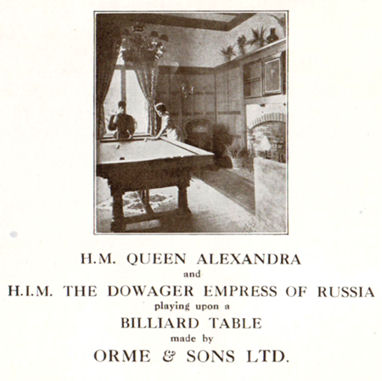
The majority of this history was
written by, and is the copyright of, Peter Ainsworth , who
kindly gave his permission for its use in this article and add
other bits of information taken from the heritage collection
files.
At the height of their fame, Orme
& Sons attained recognition as one of the most important
billiard table manufacturers in the country, a status which only a
handful of manufacturers outside London ever achieved.
The business was founded in 1845, and
by 1856 they were operating from premises at 1 St. Ann Street and
27 Littlejohn Street in Manchester. Trading at this time as "Thomas
and James Orme, billiards and bagatelle table manufacturers" they
advertised "a large assortment of new and secondhand billiards and
bagatelle tables, French and English cues, cue racks and stands,
billiards, pool, pyramid and bagatelle balls, cue-tips, rules of
the games, cloths of the finest texture, marking boards, mats and
matting." With workmen available for repairs and renovations, they
were already, at this early stage in their history, supplying the
full range of trade requirements.
Made in a day
There was an interesting episode in
December 1870, when William Cook, Joseph Bennett and John Roberts
Jnr; were engaged to play in a series of matches at the Town Hall,
Manchester. All had been holders of the Professional Billiards
Championship during the course of that year and there was great
public interest in their appearance. For this occasion Orme's
offered to fully equip the room, building from scratch, all the
components from table to balls and marking board, ready for play,
in 24 hours.
In this challenge to themselves they
were successful, the work being commenced at 12.30 a.m. on the
morning of December 6th and completed by 11.45 p.m. the same day.
The Sportsman newspaper informs us that this was no mere assembly
job. "Sixty men were engaged and they entered thoroughly into the
spirit of the task. The timber (mahogany) had all been laid out,
slates, ivory for the balls and all the other material for the
cues, marking board, etc., and strip rubber cushions (eight strips
on the sides and nine on the ends [this description indicates
that they were built up rubber cushions from strips of rubber - see
Norman's Articles Days of Old No.4])." A truly spectacular
feat which demonstrated their all-round capacity and earned them
extensive national publicity.
By 1874 the company was trading as
"Orme & Sons" and they became the first to publish their own
specialist magazine called "The Billiard Journal," an initiative
which would be copied the following year by Burroughes & Watts.
Neither publication was particularly successful and both were
short-lived, however it demonstrated the initiative and ambition
being shown by Orme's at this time. They were also active in
helping to generally promote billiards competitions, and in 1876
provided a trophy cup valued at 140 guineas for the first billiard
championship of Ireland. This tradition was maintained throughout
their trading history, and many amateur Leagues in this country
still hold trophies engraved with the name of Orme & Sons.
In 1880 Orme's expanded their
operations to Glasgow, where they established a branch office at 53
Vincent Street. They had now acquired the accolade of royal
patronage, having received a warrant from Edward, Prince of Wales
and from this date the three feathers, emblem of the Prince, were
prominent in their advertising and on their products.
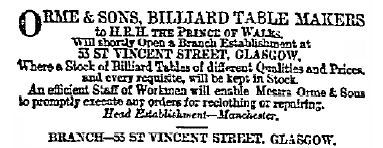
Orme's announced their arrival
in Glasgow with the above advert in the Scotsman August 1880. Their
promotion of the "Ivorine" billiard balls appeared in the same
newspaper a year later

Always keen to adopt new innovations,
Orme's were one of the first suppliers of composition billiard
balls. Their adverts at this time proclaiming - "Ivorine
Billiard Balls. Try them. If not approved of taken back. Half the
price of ivory." These were amongst the earliest of composition
balls on the market at a time when much experimentation in various
formulas would ultimately result in Bonzoline and Crystalate
emerging from the pack as a genuine replacement for ivory a decade
later.
In 1881 a notice appears in the
newspapers announcing that the involvement of P. Colles as a
partner in the firm had been terminated. The remaining partners
being recorded as T. Orme, A. H. Colles.
Two years later [1883] the
company moved up the road from No. 1 St. Ann Street, Manchester, to
occupy Nos. 11 and 13. No further reference is made to the
Littlejohn Street premises, which was presumably closed at this
time.
A significant point in the history of
the firm occurred in 1885 when they were instrumental in the
formation of the Billiard Association, Mr. A. H. Collis-Orme being
a member of the original committee, taking the chair on several
occasions. Although the new association discussed the idea of an
Amateur billiards championship for the Great Britain and Ireland,
this did not materialise, and the new governing body
focussed its attention on revisions to the rules and
the professional game. It was left to Orme's to again take the
initiative by establishing the event themselves, and the final
stages of the inaugural competition was held in Manchester in 1888.
They continued to run the Amateur championship until eventually
handing over its operation to the Billiard Association in 1893.
In 1887 Orme's were commissioned
to make a table for the Queen Victoria's Jubilee exhibition in
Manchester and they produced a historic table not just because it
had references to Queen Victoria's 50 year reign carved into its
panels but historic also in its quality a true work of the billiard
table makers art. Currently August 2009 this table is on display is
in Harrods. In 2011 there was an article in a Magazine about
Antiques noting its sale. It is a rather spledid table and
perhaps it is worth reading the sale notes from a previous sale of
the table in 1913, which included the information that the table
was sold from the 1887 exhibition for 1000 guineas, approx
£75,000.00 if valued today (2009).
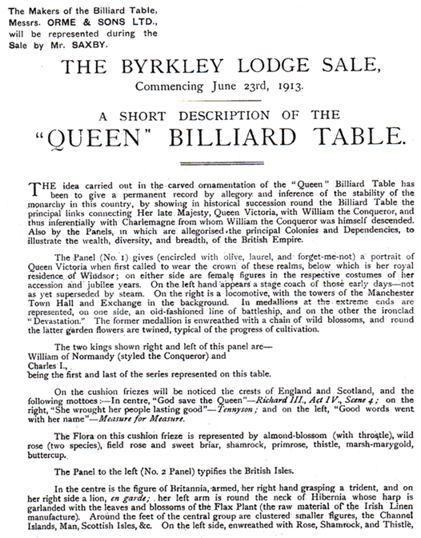
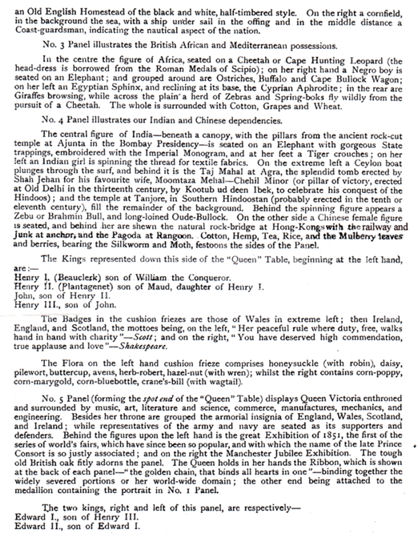
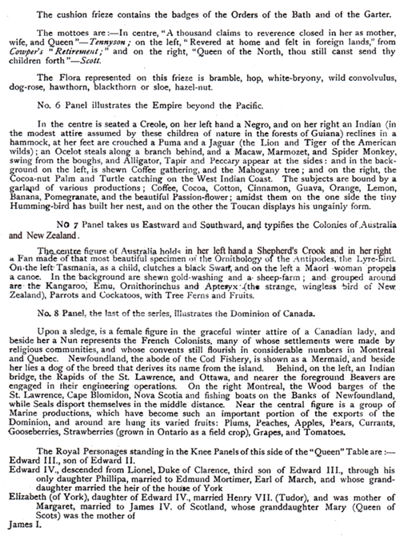
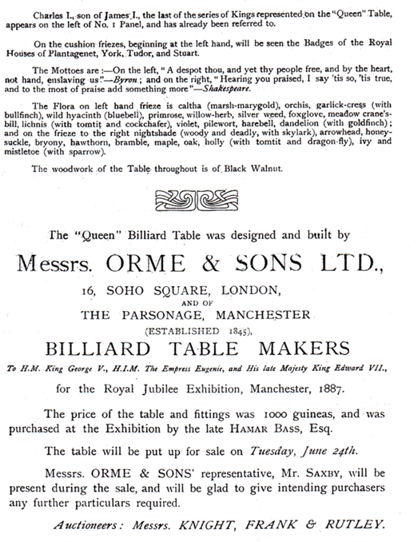
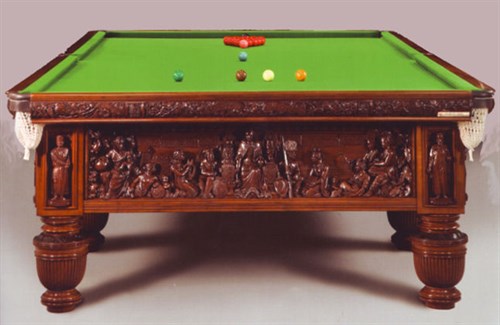
This picture shows the quality
of the carving on the Exhibition Table

details of panel No.1 from the 1887 Orme & Sons Exhibition
Table
In 1890 Orme's had showrooms and a
matchroom at Blackfriars Street in Manchester, which would become
popularly known as "The Parsonage" and also established a presence
in the capital when they opened a similar facility at 16 Soho
Square, London. They now staged their Amateur Championship at this
location together with other important events in the billiards
calendar. Another change of address followed in Glasgow when they
moved from Vincent Street to St. George's Place.
A Curious Libel
With interest being revived in the
Professional Billiards Championship the Billiard Association
decided to run two championship events, and for these they produced
a set of pocket templates with the
aim of providing a "standard" pocket
opening. The honour of staging the championships was
decided by lot from amongst the leading makers, and Orme's were
selected to run the "all-in" championship at their new London
Showrooms between 6th - 9th April 1892. The pockets were checked by
a representative of the Billiard Association on 31st March, a week
before the event, and declared in conformance with the template.
However, the table was also to be used for the Orme Amateur
Championship and the cushions were immediately removed and another
set put on for this event. On the conclusion of the Amateur
Championship the table was recovered, and the original cushions
restored. But all was not well. On the first day of play it
appeared as though the top pockets, favoured by the
spot-stroke players, were "too easy". In fact, William Peal[, on
the final day, made a break of 2,099, the highest ever recorded in
a championship match. However, the Billiard Association refused to
recognise the effort and a war of words ensued in the
sporting press.
The Billiard Association referee, Mr.
G. T. Dunning, who had originally checked and certified the table,
was imprudent enough to accuse Orme's of deliberately altering the
table after his inspection, which resulted in a writ for libel
being issued against him. The arguments centred on the 1/8 inch
bevelling of the slate at the pocket opening, which
Orme claimed was necessary to fit the cloth, and was already
present at the time of the initial inspection. Against this
argument the defence contended that the bevel had
become more significant by the end of the professional
championship.
In addition to the changes to the
table required for the Amateur Championship, the match conditions
of the "all-in" championship stipulated the fitting of a new cloth
every day. The cushions had therefore been removed and replaced
many times since the original certificate of conformity was issued,
and the slate regularly exposed. This being the first time that
templates had been used for a championship match, it seems that
nobody though it prudent to have them available when the cushions
were replaced! After two days of legal argument the jury could not
agree a verdict and the case was dismissed.
The year of 1896 was a momentous one
in their history as they were incorporated into a Limited Company,
thereafter styling themselves, "Orme & Sons Ltd." The London
premises at 16 Soho Square was rebuilt and re-opened, and during
the same year the Glasgow branch of the business was also relocated
again, this time making the move to 69 West Nile Street.
The New Century
Following the Death of Queen Victoria
in 1901, the warrant awarded by the Prince of Wales was now
converted into a royal warrant from King Edward VII, which was
again displayed prominently in their advertising. Further expansion
of the company followed, with additional branch offices being
opened at 53-55 North John Street, Liverpool and 43 Arthur Street,
Belfast, and works were established at Stockport.
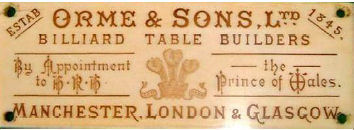
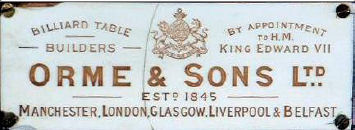
The table plates above show the
use of the Prince of Wales feathers, and the Royal Warrant awarded
when he became King Edward VII in 1901
In 1906 they received their first
contract for the supply of their O.S.
[Orme &
Sons] Cushions to H.M. War Office "for
use on billiard tables at Home and Foreign Stations." This was a
significant three-year contract which they would subsequently
renew.
Another heavily carved table by
Orme's was their 'Beaufort' model as shown in illustration taken
from their catalogue circa 1905.
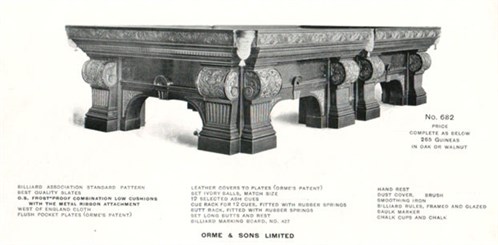
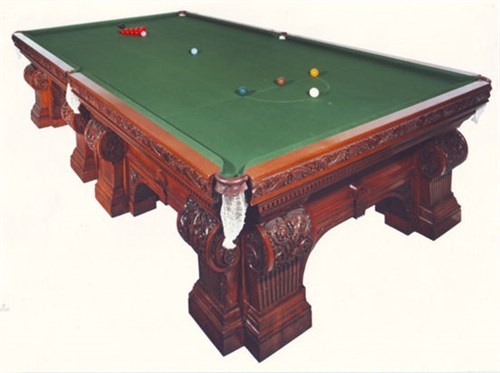
Thurston sold a table of this
design in the 1970's only to buy it back again a few years later
and were then able to find another client for it. The following
pictures show the quality of the carvings and the fact that the
wood work for the table was 'massive' making this table weigh in at
almost 2 tonne. Anyone who has read 'A Trade History' compiled by
J.R. Mitchell will have seen the carving as the pictures were used
for the front & back covers of the book.
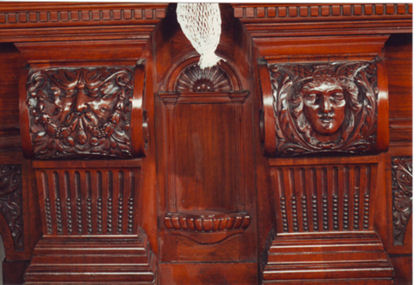
Carvings a middle legs
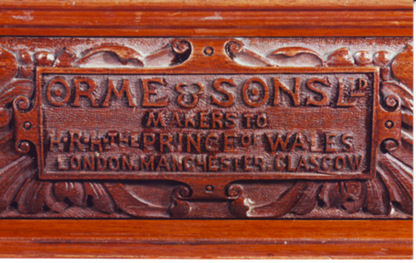
Makers plated carved into
cushion slide
At this time there was a revival of the fashion for strangely
shaped billiard tables with most of the leading manufacturers
adopting and promoting its own unique shape. Orme's elected for an
oval table which became known as the "Arc-Oval" and in 1907
established a new trading entity called The Oval Billiards Company
to promote its use. The most famous professional of his day, John
Roberts, was lured out of retirement to perform a series of matches
upon it, but despite this blaze of publicity the innovation was
short-lived, and the experiment was terminated within a couple of
years. A paragraph in the magazine 'Billiards and Snooker'
dated June 1937 recalls that -"The Oval-shaped table
favoured eccentric cannon effects, and
Freddy Weiss ('Champion' of Australia) was in his element. Roberts
was more reserved; for once in his career the opposition was
getting the best of the showmanship...' E.A. Clare who was one of
Orme's Irish representative / fitter (between 1903-1912) at this
time sold a few of these tables but told that a few years later
they were scrapped for just a few pounds [read more about
E.A. Clare in).
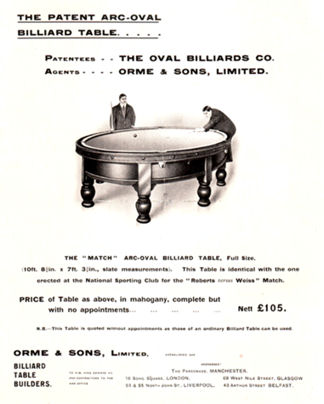
It seems that Orme & Sons
Ltd. were apponted agents for the Oval Billiard
Table
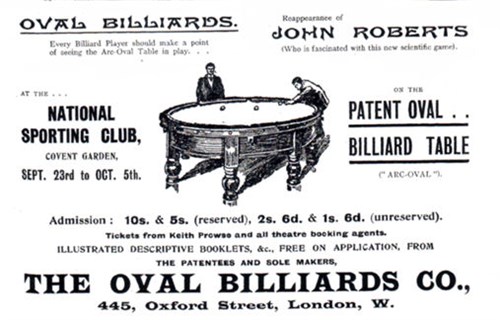
Just adding a bit of information
to Peter Ainsworth's history - in about 1903 Mr. E. A. Clare the
founder of E.A. Clare & Son sommenced work for Orme & Sons
and worked for them until 1912 when he started his own business in
Liverpool. Orme's did give him a rather short , curt referance as
shown -
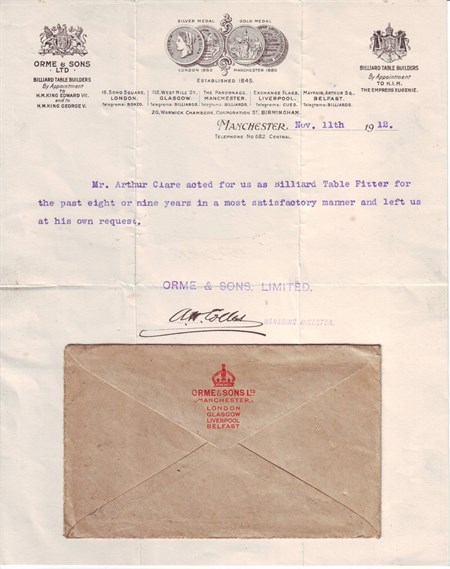
Another innovation, widely copied
amongst the leading manufacturers, was the "bottomless pocket"
which allowed the retrieval of balls without having to fish them
out from the top. Orme's version, the "Bottomless Rapid Pocket" was
introduced in 1908, the ball being gathered by raising a "gate"
with the tips of the fingers, which allowed the ball to fall into
the hand.
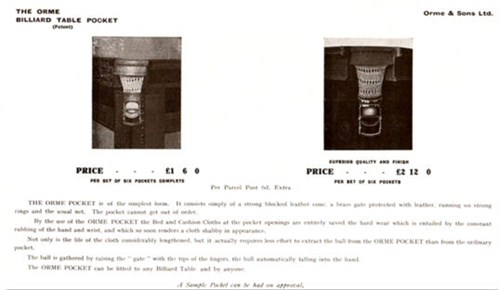
In 1909, Orme's had new showrooms at
Exchange Flags, Liverpool, and were advertising a network of
"Resident Workmen" in Birmingham, Leeds, Newcastle-on-Tyne,
Northampton, Portsmouth, Cardiff, and Dublin who could carry out
the repairs and installations for a booming business.
After the death of King Edward in
1910, the firm continued to receive royal patronage, and obtained a
warrant from King George V. Some of their finest work was done at
this time, which undoubtedly represented the zenith of their fame
and fortune.
The World
Wars
The Great War had a devastating effect
on many billiard table manufacturers, with import of materials
brought to a sudden halt and all production stopped or turned over
to the war effort. Most of the staff of fighting age would either
volunteer or be conscripted into the armed forces, many skilled
workers never to return. Even after hostilities ceased, and it was
possible once more to import the timber necessary for their trade,
a worldwide recession did nothing to help recovery of pre-war
glories.
In 1928, with many businesses still
struggling, there was an important fusion of interests in the
billiard table world when Orme and Sons (who had already acquired a
controlling interest in Messrs. Camkin, Ltd., of Birmingham) joined
with George Wright and Co., London, and Fred Heyes, of Preston. The
new company continued to trade as Orme and Sons Limited, with
headquarters in Manchester, and branches in London, Glasgow, Hull,
Liverpool, Birmingham, Cardiff, Belfast and Dublin. Mr. T. O.
Colles (chairman) and Mr. T. O. Williams (director), resigned their
positions, but Mr. Perry S. Hudson retained his seat on the board,
and continued to act as works manager. The other directors were,
Mr. Harold C. Coxon, of Home Recreations Ltd., billiard table
manufacturers of Sydney, Australia, (Commercial Manager), Mr. Fred.
Heyes, and Mr. William Sutcliffe, (also a director of Messrs. James
Cooper and Co., Ashton-under-Lyne), while Mr. J. J. Mallon, took up
the position as chairman of the new Board.
Notwithstanding this amalgamation, the
new company continued to struggle, and in 1931 they made an
arrangement with Burroughes & Watts to share their distribution
facilities as a means for both companies to reduce their costs
whilst continuing to trade independently. As a consequence the
London showrooms at 16 Soho Square were relinquished and business
conducted from the Burroughes & Watts amenities across the road
at 19 Soho Square. This arrangement was sustained until the
outbreak of war again brought all manufacturing activities to a
standstill.
The
Endgame
Orme's continued to advertise for a
few years after this, but it would appear that essentially the
business was soon absorbed into Burroughs & Watts, and probably
at some point prior to the outbreak of the second World War, they
became a wholly owned subsidiary of the London based company.
Although the Orme name continued to be
registered with Companies House the only reference to them in an
operating capacity after the war is made in long standing
maintenance contracts for recovery and refurbishing Orme tables
installed many years previously. However by this time all such work
was being performed by Burroughs & Watts employees, the Orme
business having effectively closed down.
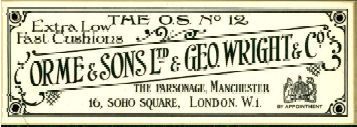

The two cushion plates above used after their amalgamation
with Geo.
Wrights in 1928. The second plate used after their arrangement
with Burroughs & Watts in 1931,
which brought about a move to 19 Soho Square.
It is perhaps worth
mentioning that by 1938 Burroughes & Watts were listing the
Manchester address as - 'The Parsonage' and
by 1949 showed it as being 4 Trevelyan Bldgs ,52
Corporation Street. The last address for Ormes. Certainly
when Burroughs & Watts were absorbed by Rileys and closed the
19 Soho Square address, in 1967, there was no mention of the Orme
name as indicated
programmeproduced to 'celebrate'
its passing.
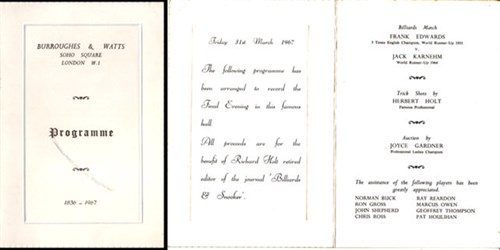
©Peter Ainsworth 2009 & ©E.A.
Clare & Son Ltd.2009.
Acknowledgements
Peter Ainsworth
'Billiard & Snooker - A Trade
History' complied by J.R. Mitchell
Snooker Heritage Collection
*********************
© E.A. Clare & Son Ltd.
2018. © Peter N. Clare 2018
Reproduction of this article allowed only with the permission from
E.A. Clare & Son Ltd.
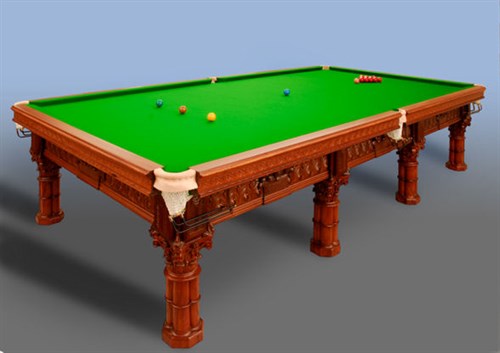
A splendid example of a
bespoke Orme & Sons or Burroughes
& Watts table, it does have Burroughes & Watts
steel block cushions fitted Thurston have carefully restored the
table which is on display in their Liverpool showroom ready
for a discerning player who wants not only a snooker table but also
a period piece of furniture.
Thurston have antique Orme & Sons
tables ready for restoration as well as a antique Billiard Tables
by other recognised manufactures such as Ashcroft, E.
J. Riley, Thos. Padmore and Burroughs & Watts.
Thurston also have a new tables of
their own manufacture for Snooker, Pool and Billiards as well as a
full range of quality accessories at very competitive prices.
Just contact the Sales department on
44(0)151 482
2700
visit the e-shop at -
www.thurston.co.uk
email - thurston@eaclare.co.uk
Go to Top of Page

